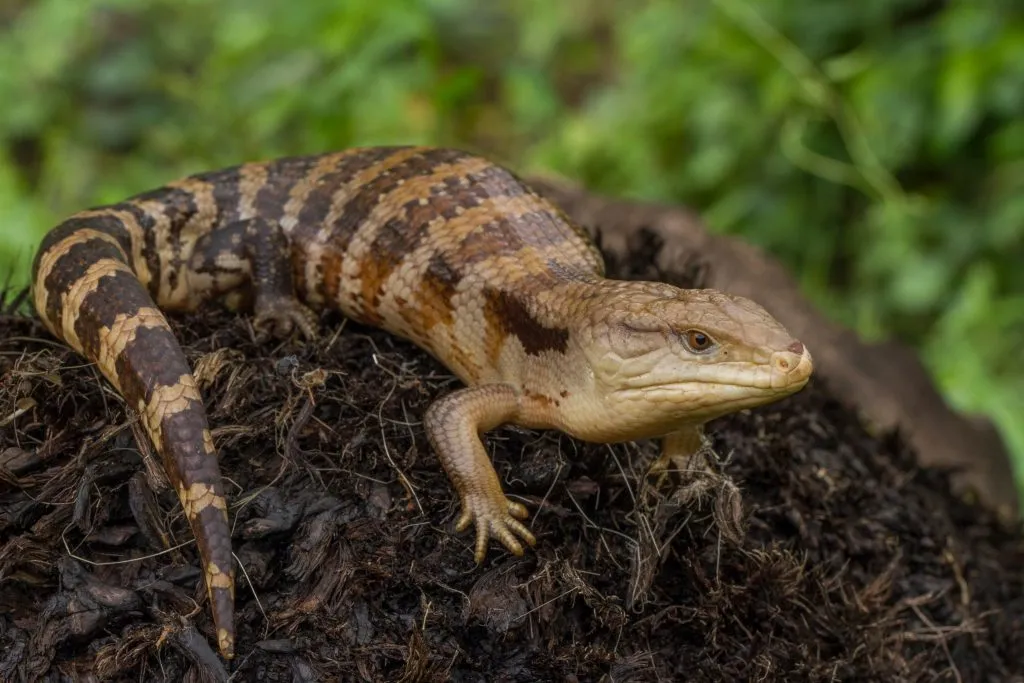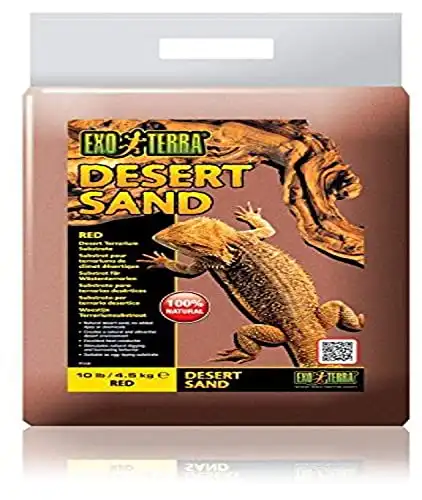
Which substrate should you use for your blue tongue skink? Is it okay to use a reptile carpet? Will it be better to use loose substrate for their digging and burrowing behavior? Will the loose substrate cause impaction?
The best substrates for blue tongue skinks are coconut fiber, aspen, cypress mulch, and a bioactive setup. These substrates not only cater to the love for digging and burrowing of blue tongue skinks, but they also play a role in maintaining humidity.
If a loose substrate is the best choice for a blue tongue skink, how about the risk of impaction? We will address this concern in this read and differentiate the type of blue tongue skinks and what substrate will work best for them.
Table of Contents
Best Substrates For Blue Tongue Skinks
Let us take a look at the best substrate choices for your blue tongue skink
1. Zoomed Eco Earth
Is coconut fiber good for a blue tongue skink? Yes, it is. A lot of blue tongue skink owners, especially those who have Indonesian blue tongue skinks use this substrate for its humidity component.
As this coconut fiber substrate comes compressed, some owners break it down manually to loosen it.
Pros
- 100% natural
- Encourages burrowing and digging behavior
- Helps increase humidity
Con
- Some ends may be sharp when not broken down
2. Exo Terra Coco Husk
This is a good choice for those who are concerned with impaction. The chips are big enough that they cannot be accidentally ingested.
It can also increase the humidity in the
Pros
- 100% natural
- Helps maintain humidity levels
- Stimulate burrowing and digging behavior
- Low risk of impaction
Cons
- The texture is unlike soil, it is not as soft
- Some big chunks are not broken down easily
3. Zoomed Aspen Bedding
If you want to use aspen as substrate, make sure that you pick the one that is shaved and not shredded. Owners may be concerned with how loose this substrate is as it may risk impaction.
Keep in mind that healthy reptiles do not get completely impacted due to accidental ingestion of substrate.
Sure, they can get impacted if they have been ingesting cups of substrate every feeding which is very unlikely.
Tip: We have bought and tested the Aspen Snake Bedding. Read our review here!
But usually, impaction is caused by other factors wherein the accidental ingestion of substrate is a minor collaborator.
Healthy blue tongue skinks can easily pass some substrates that were eaten accidentally, while those that already have internal issues may find some trouble with it.
Pros
- Usually does not contain debris and dust
- Soft bedding
- A breeze to clean
- The risk of impaction is low
Cons
- May have a weird smell
- Mites can thrive if not habitually cleaned
Note: Some substrates can contain mites. For extra precaution you can bake or freeze it first.
4. Zoomed Forest Floor Bedding
A lot of owners also use cypress mulch as their substrate, as it mimics the environment in the wild. This substrate also can hold moisture which helps with humidity.
Pros
- Aesthetically pleasing
- Encourages burrowing behavior
- Good for high humidity
Cons
- Can be infested with mites when not cleaned
- A bit difficult to clean
5. Arcadia Earth Mix Arid
A lot of owners have been setting up bioactive enclosures nowadays. This is actually not just a fad as there are many benefits to having a bioactive setup. You have natural cleaners and it mimics life in the wild which makes for good enrichment for your blue tongue skink.
If you want to go this route, make sure to use plants that are not toxic to your blue tongue skink. As for the substrate, it is best to mix two types. Some owners use organic soil mixed with sphagnum moss and leaf litter.
Pros
- Does not need to be cleaned regularly
- Looks nice
- Can enrich the life of your blue tongue skink
Cons
- May be difficult to set up for beginners
- Needs a lot of trial and error to balance all living organisms inside the
tank
If you are not sure about the lighting setup of your enclosure, you can check out this article here.
6. Josh’s Frogs BioBedding
This substrate will be perfect for blue tongue skinks that hail from the northern regions as they are used to tropical environments. However, it can also work for other types of blue tongue skinks that require high humidity as this substrate can also maintain high humidity levels.
Pros
- Healthy substrate for isopods and springtails
- Looks natural
- Plants will thrive in this substrate
- Helps increase humidity
Con
- It can grow bugs while in storage, you need to freeze or bake it before using
7. Zoomed Excavator Clay
This type of clay substrate is perfect for burrowing behavior. Your blue tongue skink can dig tunnels that can also hold its shape. Moreover, it works well with moisture as it dries quickly. It is also soft enough to not injure your blue tongue skink.
Pros
- Works as enrichment for blue tongue skinks
- Sift texture
- Holds moisture well
- Dries fast
Cons
- It does not come with directions in terms of how much water to add. You may add a lot of water which will cause it to break down and crack.
- Not that easy to clean
8. Exo Terra Plantation Soil And Exo Terra Desert Sand
You can also opt to mix two substrates which can help your fauna and microfauna thrive in your bioactive setup. Make sure that the soil does not contain fertilizers.
Ideally, the sand should be fine or at least a type of sand that does not contain calcium. Other types of sand can be too rough for your blue tongue skink. The ratio is 50:50.
Pros
- Ideal for increasing humidity levels
- Healthy substrate for plants
- Encourages burrowing behavior
Con
- Sand particles that are not mixed well may contribute to impaction (unlikely if your BTS isn’t suffering from calcium deficiency)
9. The Bio Dude Terra Sahara Bioactive Kit
This is the best to get if you have no idea how to set up a bioactive enclosure. With this kit, you already have everything you need.
You have three substrates (terra sahara, sphagnum moss, leaf litter) that help with humidity and are also perfect for fauna and microfauna to thrive in the enclosure.
Their kits can accommodate 10-100 gallon tanks. All you have to do is to pick the gallon size.
Pros
- Easy to set up, everything you need is in the kit
- Naturally sourced substrate
- Helps increase humidity
- Healthy substrate for fauna and microfauna
Con
- Kit does not come with isopods and springtails
10. Paper Towels
This type of substrate is best for baby blue tongue skinks or even sick blue tongue skinks. It is soft enough to not injure them and it is also readily available.
Keep in mind that you should not house your blue tongue skink in an enclosure with a paper towel substrate permanently.
It should only be used on select occasions like when you are quarantining a new blue tongue skink or taking care of a sick one.
Which Substrate To Use Based On The Type Of Blue Tongue Skink

There are about 12 types of blue tongue skinks and each type requires a different humidity level. This is important to know as the substrate that you will use helps in maintaining humidity or even raising the humidity.
Breeders usually categorize the types into two. The Australian blue tongue skink and the Indonesian blue tongue skink. Let us take a look at their humidity requirements and the matching substrates.
Australian Blue Tongue Skink Substrate
- Pygmy blue tongue skink
- Singleback
- Blotched blue tongue skink
- Central blue tongue skink
- Western blue tongue skink
- Eastern blue tongue skink
- Tanimbar blue tongue skink
This type of blue tongue skink needs a moderate humidity level. The best options are aspen, coconut fiber, and cypress mulch.
Indonesian Blue Tongue Skink Substrate
- Irian Jaya blue tongue skink
- Kei Island blue tongue skink
- Merauke blue tongue skink
- Classic Indonesian blue tongue skink
This type needs high humidity. Therefore, the substrate cannot only retain moisture but can also dry a bit fast. The best options are coconut fibers, coconut husk, cypress mulch, and sphagnum moss.
Substrate Setup For Blue Tongue Skinks
Most substrates are ready to use. All you need to do is to dump them in the enclosure. However, there are some that need a bit of preparation.
An example of this is sphagnum moss. Before placing it in the enclosure you should first rehydrate it with water. This is a good source of humidity which is why it is best mixed with other substrates rather than by itself.
You can also opt to mix substrates. If you are using coco fiber, you can mix it with sphagnum moss. There are also other owners that mix aspen with cypress mulch.
Make sure that the depth of your substrate is at least four to six inches deep to make sure that your blue tongue skink can dig in the enclosure.
Is It Good To Use A Reptile Carpet For Blue Tongue Skinks?

Reptile carpet is usually the choice if you want fast clean-ups and easy setups. For the most part, it is fine to use, except blue tongue skinks love to dig and burrow.
A lot of owners that use reptile carpets have found their skinks underneath the carpet.
At the same time, reptile carpets do not provide the proper enrichment for your blue tongue skink. This can lead to boredom and even obesity due to lack of exercise.
Some owners add a bit of substrate on a part of the enclosure covered with reptile carpet (for digging purposes), but blue tongue skinks can easily drag the substrate and make a mess.
It is so much easier to use other substrates completely rather than piling them on a reptile carpet.
Do Blue Tongue Skinks Need Sand?
No. Blue tongue skinks do not need sand. If there is one substrate you should absolutely avoid using for your blue tongue skink, it is definitely sand.
Substrates like calci-sand, fish gravel, crushed walnut shells, alpha pellets have sharp edges to them that can injure your blue tongue skink.
More than that, these substrates are small enough to ingest easily, aiding impaction.
Conclusion
In choosing a substrate for your blue tongue skink, you should first determine what type it is. In this way, you will know if the substrate that you should pick can contribute moderately or highly to humidity levels.
As for the substrates themselves, coconut fiber/husk, aspen, cypress mulch, and bioactive bedding are still the top choices.
Mainly because they are soft, less likely to be ingested in large amounts, and encourage the digging and burrowing behavior of blue tongue skinks.
- Enchi Ball Python: A Unique and Stunning Morph of Python regius - March 27, 2025
- Emerald Tree Monitor: The Enigmatic Green Guardian of the Rainforest - March 26, 2025
- The Egyptian Cobra (Naja haje): A Fascinating Serpent - March 25, 2025









